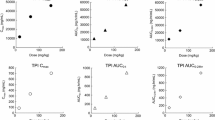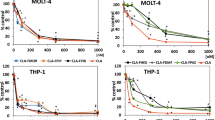Summary
5-Trifluoromethyl-2′-deoxyuridine (CF3dUrd), an antitumor agent, is known to be short-lived in human plasma. Since its rapid elimination from the blood-stream seems to have descouraged the clinical evaluation of this drug, we explored the potential use of masked derivatives of CF3dUrd as “depot” forms of the parent compound. First, we observed that the toxicity of CF3dUrd against HeLA cells in culture was 104 times greater for a 24-h treatment as compared with a 1-h treatment at identical concentrations of the drug, which suggests the importance of using a prolonged treatment period. In fact, the divided dosing of CF3dUrd to L1210-bearing mice was markedly more effective than its single administration. 5′-O-Hexanoyl-,N 3-p-butylbenzoyl-, 5′-O-benzyloxymethyl-, and 3′-O-benzyl-CF3dUrd were found to be effective in maitaining the CF3dUrd concentration in plasma. The oral doses of these agents required to achieve 50% growth inhibition (ED50) in mice bearing sarcoma 180 tumors were 19, 34, 10, and 13 mg kg−1 day−1, respectively, whereas that of CF3dUrd was 63 mg kg−1 day−1. The ED50 values for these compounds were inversely correlated with the residence time of CF3dUrd in plasma. The therapeutic indices of these compounds, calculated as the dose producing a 50% inhibition of body-weight gain (IB50) divided by the ED50 value (1.89, 1,21, 1.40, and 2.15, respectively), were significantly higher than that of CF3dUrd (0.78). Consequently, these depot forms of CF3dUrd, particularly 3′-O-benzyl-CF3dUrd, are expected to be more useful than the parent compound as antitumor agents.
Similar content being viewed by others
Abbreviations
- CF3dUrd:
-
5-trifluoromethyl-2′-deoxyuridine
- CF3dUMP:
-
5′-trifluoromethyl-2′-deoxyuridine-5′-monophospate
- S180:
-
sarcoma 180
- L1210:
-
L1210 leukemia
- kel :
-
elimination rate constant
- T1/2:
-
half-life time
- AUC:
-
area under the curve
- ILS:
-
increase in life span
- TS:
-
thymidylade synthase
- FdUMP:
-
5-fluoro-2′-deoxyuridine-5′ monophosphate
- FUra:
-
5-fluorouracil
References
Ansfield FJ, Ramirez G (1971) Phase I and II studies of 2′-deoxy-5-(trifluoromethyl)-uridine (NSC-75 520). Cancer Chemother Rep 55: 205
Bresnick E, Williams SS (1967) Effects of 5-trifluoromethyl-deoxyuridine upon deoxythymidine kinase. Biochem Pharmacol 16: 503
Dexter DL, Wolberg WH, Ansfield FJ, Helson L, Heidelberger C (1972) The clinical pharmacology of 5-trifluoromethyl-2′-deoxyuridine. Cancer Res 32: 247
Fujiwara Y, Oki T, Heidelberger C (1970) Fluorinated pyrimidines: XXXVII. Effects of 5-trifluoromethyl-2′-deoxyuridine on the synthesis of deoxyribonucleic acid of mammalian cells in culture. Mol Pharmacol 6: 273
Gordon HL, Bardos TJ, Chmielewicz ZF, Ambrus JL (1968) Comparative study of the thymidine kinase and thymidylate kinase activities and of the feedback inhibition of thymidine kinase in normal and neoplastic human tissue. Cancer Res 28: 2068
Heidelberger C, Anderson SW (1964) Fluorinated pyrimidines: XXI. The tumor-inhibitory activity of 5-trifluoromethyl-2′-deoxyuridine. Cancer Res 24: 1979
Heidelberger C, Parsons DG, Remy DC (1964) Synthesis of 5-trifluoromethyluracil and 5-trifluoromethyl-2′-deoxyuridine. J Med Chem 7: 1
Heidelberger C, Boohar J, Kampschroer B (1965) Fluorinated pyrimidines: XXIV. In vivo metabolism of 5-trifluoromethyluracil-2-14C and 5-trifluoromethyl-2′-deoxyuridine-2-14C. Cancer Res 25: 377
Ikenaka K, Fukushima M, Nakamura H, Okamoto M, Shirasaka T, Fujii S (1981) Metabolism of pyrimidine nucleotides in various tissues and tumor cells from rodents. Jpn J Cancer Res 72: 590
Maehara Y, Nakamura H, Nakane Y, Kawai K, Okamoto M, Nagayama S, Shirasaka T, Fujii S (1982) Activities of various enzymes of pyrimidine nucleotide and DNA syntheses in normal and neoplastic human tissues. Jpn J Cancer Res 73: 289
Reyes P, Heidelberger C (1964) Inhibition of thymidylate synthetase by fluorinated nucleotides. Fed Proc 23: 278
Reyes P, Heidelberger C (1965) Fluorinated pyrimidines: XXVI. Mammalian thymidylate synthetase: its mechanism of action and inhibition by fluorinated nucleotides. Mol Pharmacol 1: 14
Rowland M, Tozer TN (1980) Clinical pharmacokinetics: concepts and applications. Lea and Febiger, Philadelphia, p 288
Sneider TW, Potter VR, Morris HP (1969) Enzymes of thymidine triphosphate synthesis in selected Morris hepatomas. Cancer Res 29: 40
Spears CP, Shahinian AH, Moran RG, Heidelberger C, Corbett TH (1982) In vivo kinetics of thymidylate synthetase inhibition in 5-fluorouracil-sensitive and-resistant murine colon adenocarcinomas. Cancer Res 42: 450
Spears CP, Gustavsson BG, Mitchell MS (1984) Thymidylate synthetase inhibition in malignant tumors and normal liver of patients given intravenous 5-fluorouracil. Cancer Res 44: 4144
Wataya Y, Santi DV, Hansch C (1977) Inhibition ofLactobacillus casei thymidylate synthetase by 5-substituted 2′-deoxyuridylates. Preliminary quantitative structure-activity relationship. J Med Chem 20: 1469
Yamashita J, Takeda S, Matsumoto H, Terada T, Unemi N, Yasumoto M (1987) Studies on antitumor agents: VI. Syntheses and antitumor activities of acyl derivatives of 2′-deoxy-5-trifluoromethyluridine. Chem Pharm Bull 35: 2090
Yamashita J, Takeda S, Matsumoto H, Unemi N, Yasumoto M (1987) Studies on antitumor agents: VII. Antitumor activities ofO-alkoxyalkyl derivatives of 2′-deoxy-5-trifluoromethyluridine. Chem Pharm Bull 35: 2373
Yamashita J, Takeda S, Matsumoto H, Unemi N, Yasumoto M (1989) Studies on antitumor agents: VIII. Antitumor activities ofO-alkyl derivatives of 2′-deoxy-5-(trifluoromethyl)uridine and 2′-deoxy-5-fluorouridine. J Med Chem 32: 136
Author information
Authors and Affiliations
Rights and permissions
About this article
Cite this article
Takeda, S., Wierzba, K., Yamashita, Ji. et al. Potentiation of the antitumor activity of 5-trifluoromethyl-2′-deoxyuridine by the use of depot forms of the parent compound. Cancer Chemother. Pharmacol. 30, 360–364 (1992). https://doi.org/10.1007/BF00689963
Received:
Accepted:
Issue Date:
DOI: https://doi.org/10.1007/BF00689963




